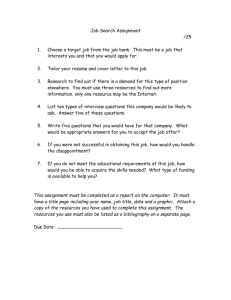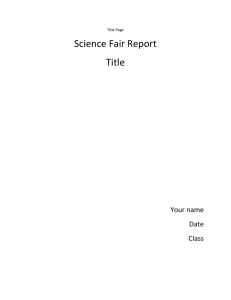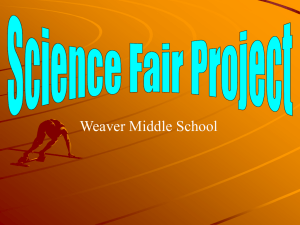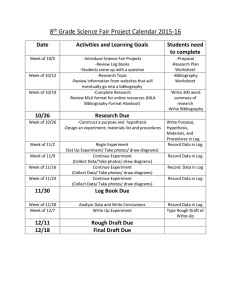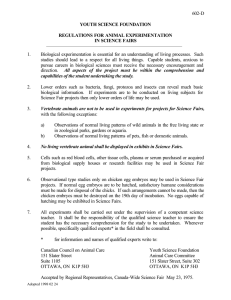Science Fair Research Process - State Science and Engineering
advertisement
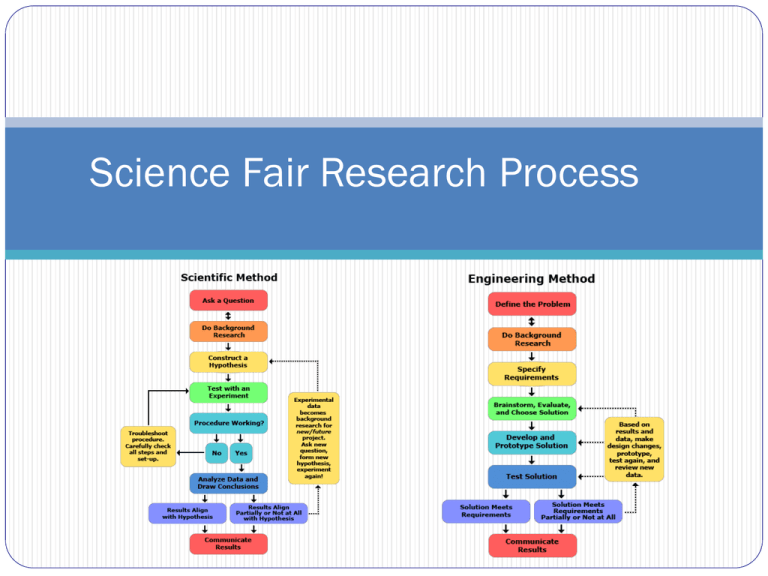
Science Fair Research Process Supports Common Core Standards such as….. Reading, writing and research involved in student science fair projects are one way for students to achieve the rigor and critical thinking evident in the Common Core Standards Cite specific textual evidence to support analysis of science and technical texts Follow precisely a multistep procedure when carrying out experiments, taking measurements, or performing technical tasks Integrate quantitative information expressed in words in a text including information expressed visually (graph, etc) Compare and contrast information Write informative/explanatory texts, including..scientific procedures/experiments Summarize numerical data sets in relation to their context Utilizing the 8 Practices of Science & Engineering Essential for ALL students to Learn Defined as one Dimension in the Next Generation Science Standards Framework s K-12 Asking Questions (for science) and defining problems (for engineering) Developing and using models Planning and carrying out investigations Analyzing and interpreting data Using mathematics and computational thinking Constructing explanations (for science) and designing solutions (for engineering) Engaging in argument from evidence Obtaining, evaluating, and communicating information Goals What are the characteristics of your program? Goals What are the characteristics of your program? Help students to become enthusiastic scientists Challenge students to learn the scientific method and scientific principles through experience Give students the opportunity to communicate what they have learned to others. Other……………………………….. Goals Who will Participate? Will you allow Team Projects? Ask a Question Finding a Topic Idea Imagine if someone offered you the answer to any question that’s ever perplexed you, however big or small. That’s exactly the opportunity science fairs give you – the freedom and power to explore almost any curiosity you’ve ever had, and to do it on your own. (Of course, your friends, teachers and parents are there to help.You might even decide to tag-team a project with a friend.) The first major decision to make is yours: What topic will you take on? Where will you channel your passion? Will you pick a topic dominating news headlines? Or maybe you’ll choose something you’re totally clueless about, to truly challenge yourself. The bottom line is that your future in science fairs is wide open. www.archimedesinitiative.org/choosingadventure.html What are you students’ interests? Choosing the topic/question… What do you want to study or learn about? What are your areas of interest? Hobbies? What is going on in the world around you that you want to learn more about? (home? school? work place? community?) What are the resources in your school and community? Research your topic… Literature Review: Use science journals/internet/library to learn more about your topic Seek out adults, professionals that know about your topic Look for unexplained or unexpected results Ask why? What if? Identify a “testable” question. Can variable(s) be identified and tested against original set of conditions Can the question/problem be completed in the amount of time allowed for the project? Non Inquiry Based Research Not all areas of study are best served by scientific method….BE AWARE Engineering Projects – creating things that never were Define a need…How can I make this better? Develop or establish a design criteria Background research /literature search – what has already been done and what makes it good and what makes it weak Prepare preliminary designs and materials list. Include costs and user requirements Build and test a prototype. Consider reliability, repair and servicing Retest and redesign as necessary. Product testing Computer Science Projects Creating and/or writing new algorithms to solve a problem or improve existing one Simulations, models or virtual reality are other areas Mathematics Projects Involves proofs, solving equations Math is the language of science and used to explain existing phenomena or prove new concepts or ideas Research Project Approval… Define the question/problem Teacher approval Parent approval What is the hypothesis and/or expected outcome(s)? Plan your experimental procedures Procedure – detail all procedures and experimental design to be used for data collection Include all safety procedures Must be a “controlled” experiment – one variable changed at a time Include sufficient numbers to be statistically valid Data Analysis – describe the procedures you will use to analyze the data/results that answer the research question(s) Include list of materials Bibliography – list at least 5 major resources from your literature review Include resources used to develop experimental design and/or safety procedures Required FORMS for competition… Checklist for Adult Sponsor (1) – pre-experiment Adult Sponsor/teacher carefully reviews the entire Research Plan and signs prior to experimentation Check for additional PROTOCOL FORMS that might be needed to do the experiment Student Checklist (1A) Student information Continuation? Start and end dates Where is experiment conducted? Approval Form (1B) – Student and Parent approval Understand Possible dangers HAVE READ AND WILL FOLLOW THE RULES & GUIDELINES Ethics statement SRC/IRB Approval if REQUIRED BEFORE EXPERIMENTATION Human Subjects Vertebrates Potentially Hazardous Biological Agents (PHBA’s) Hazardous Chemicals, Activities, and Devices (SSEF RULE) ATTACH COMPLETE Research Plan – Question/Hypothesis; procedures; Bibliography ATTACH PROTOCOL FORMS if required Conduct your experiment.. Log book Keep detailed notes of measurements and observations Use data tables or charts to record quantitative data Original writing Could be used to PROVE what you actually did Analyze Data Examine and organize your findings Make “pictures” (graphs) Identify patterns Did you get expected results? Why or why not? Was the experiment performed EXACTLY? Are there any other explanations not originally considered? Were there any data errors? Statistically analyze your data and be able to explain their meaning Conclusions Did the variable(s) tested cause change when compared to the standard? What patterns did you see from graph analysis? Which variable(s) were important? Did you collect enough data? It’s ok if results do not support your hypothesis Were there errors that may have caused differences? If so, what? What are the practical applications of your research? How could this project be used in the real world? How would you improve the experiment and what would you do differently? Formal Presentation of Research Abstract 250 words on one page Purpose of the experiment Procedures used Data and conclusions Research applications Official Form – www.floridassef.net Formal Presentation of Research RESEARCH PAPER Title Page and Table of Contents Introduction Materials and Methods Results Discussion Conclusions References/Bibliography Formal Presentation of Research VISUAL DISPLAY Good, scientific title Photographs – must be appropriate and cited Organized – follows a sequence Eye-catching and NEAT Correctly presented and well-constructed Must meet the Display & Safety Requirements Formal Presentation of Research JUDGING INTERVIEW The interview is the final determination of the student’s work Is it thorough – well-thought out research How much of thought and design is student’s own work Will determine if data was collected and analyzed correctly How did you come up with this idea? What was your role? What didn’t you do? What future plans do you have to continue research? What are the practical applications of your project? Final Presentation of Research JUDGING INTERVIEW Speak freely and confidently – KNOW your research Greet the judge and introduce yourself – good first impression Appearance, good manners, appropriate attire, and enthusiasm for what you are doing will impress Relax, smile and enjoy your time Judges will encourage you in your scientific efforts and future goals in science



